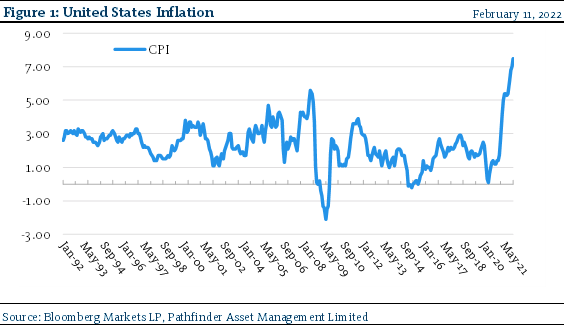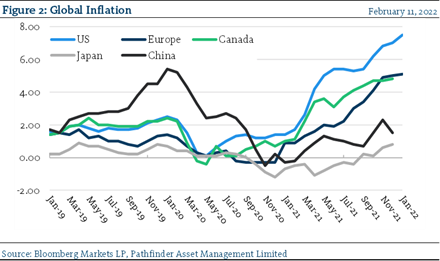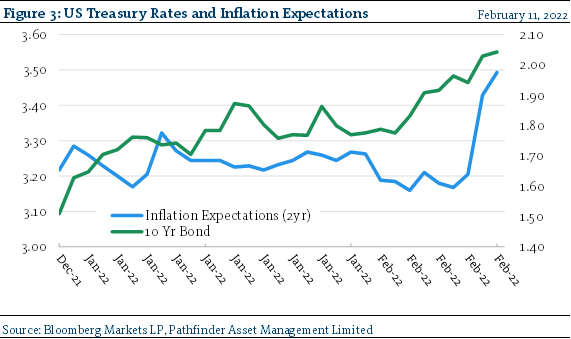Uptick in Rates
We pick up our regular note this week with a continued discussion of inflation. As we wrote multiple times last year and during our Annual Review publication (here), inflation has become an important consideration with respect to the companies we own. The US published inflation data this week and the fixed income market has reacted.
- We present US inflation for the past 30 years in Figure 1. As you can see, other than a short uptick during the commodities bull in the mid 2000’s running into the recession of 2008, inflation has tended to be range bound between 2% and 3%. The most recent increase to just over 7% is notable both because of the absolute level (one would have to go back to December of 1981 to see inflation this high) and also how quickly it has accelerated from essentially 0% in the spring of 2020.

- Figure 2 is the same data but placed on a shorter-term chart and we added other parts of the world. As you can see, the increase in prices is a global phenomenon and even Japan (grey), which has struggled with deflation for decades, is experiencing an uptick.

- Finally, in Figure 3, we highlight the fixed income markets to present the impact. Inflation expectations (blue) ramped significantly higher in the last couple of weeks and the 10-year US Treasury (green) has passed through 2% yesterday.

“This means that” inflation in now a serious consideration. It is top of mind for most investors and the financial press. Our view has changed somewhat over the year. Previously, we believed inflation would be transitory, but now we believe it will be more long term in nature. The slow resolution of supply chain and labour issues, along with effects of mitigation measures from accommodative central banks and governments will take longer to resolve, in our opinion.
National Instrument 31-103 requires registered firms to disclose information that a reasonable investor would expect to know, including any material conflicts with the firm or its representatives. Doug Johnson and/or Pathfinder Asset Management Limited are an insider of companies periodically mentioned in this report. Please visit www.paml.ca for full disclosures.
*All returns are time weighted and net of investment management fees. Returns from the Pathfinder Partners’ Fund and Partners’ Real Return Plus Fund are presented based on the masters series of each fund. The Pathfinder Core: Equity Portfolio and The Pathfinder Core: High Income Portfolio are live accounts. These are actual accounts owned by the Pathfinder Chairman (Equity) and client (High Income) which contain no legacy positions, cash flows or other Pathfinder investment mandates or products. Monthly inception dates for each fund and portfolio are as follows: Pathfinder Core: Equity Portfolio (January 2011), Pathfinder Core: High Income Portfolio (October 2012) Partners’ Fund (April 2011), Partners’ Real Return Plus Fund (April, 2013), and Partners’ Core Plus Fund (November 2014).
Pathfinder Asset Management Limited (PAML) and its affiliates may collectively beneficially own in excess of 10% of one or more classes of the issued and outstanding equity securities mentioned in this newsletter. This publication is intended only to convey information. It is not to be construed as an investment guide or as an offer or solicitation of an offer to buy or sell any of the securities mentioned in it. The author has taken all usual and reasonable precautions to determine that the information contained in this publication has been obtained from sources believed to be reliable and that the procedures used to summarize and analyze such information are based on approved practices and principles in the investment industry. However, the market forces underlying investment value are subject to sudden and dramatic changes and data availability varies from one moment to the next. Consequently, neither the author nor PAML can make any warranty as to the accuracy or completeness of information, analysis or views contained in this publication or their usefulness or suitability in any particular circumstance. You should not undertake any investment or portfolio assessment or other transaction on the basis of this publication, but should first consult your portfolio manager, who can assess all relevant particulars of any proposed investment or transaction. PAML and the author accept no liability of any kind whatsoever or any damages or losses incurred by you as a result of reliance upon or use of this publication.